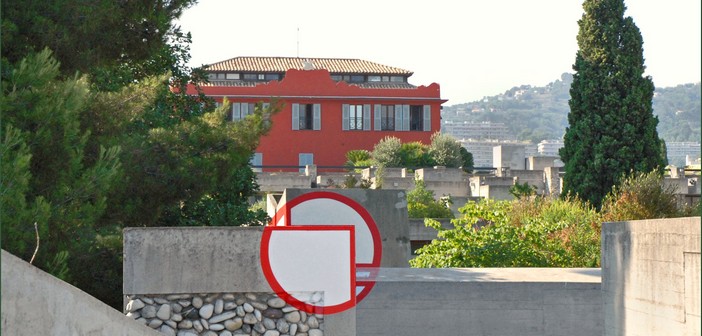The Villa Arson is inaugurating a third cycle of art studies with these four artists that we are about to discover. The students’ course will lead to a doctorate.
These four artists: Julien Dubuisson, Ibai Hernandorena, Lidwine Prolonge, and Jean Charles de Quillacq, are somewhat like the four cardinal directions, their art, their work, their approach, and their purpose distinguish them from each other, and yet, from four facets that seemingly, at first glance, have nothing in common, they have managed to create a coherent exhibition. The four acts of this exhibition offer us a theatrical piece where spontaneity and repeated performances become the successive representations of this play, whose staging serves to connect these four artists.
In the first room, we discover four elements: a rope, iron plates, a car, and a stone. Each element symbolizes an artist and is the thread to understand their approach and work.
This first room is like a garden, according to the exhibition’s curator. Lidwine Prolonge invites us to browse through archives, old newspapers, and photos including those of Françoise Dorléac. The car is her symbol, which becomes quickly apparent. Here, she conducted a performance at Nice airport by recreating Françoise Dorléac’s last boarding call.
If Lidwine is the first artist the visitor encounters, she is also the last with videos revealing the artist, the videographer, and her passion for news stories. She turns them into works of art and simultaneously into testimonies of the past that she projects into the future (1964-2064), posing the question: what about in 2064? None of us has the answer.
Jean Charles de Quillacq shares photos of his family, of himself, and presents objects balanced precariously; the rope is his element. Oedipus, the symbolism between brother and sister, the rope, umbilical cord, or blood ties? The third artist, Ibai Hernandorena, shows us photos akin to sepia contact sheets, postcards from the ‘50s to the ‘70s. “The most important thing about a postcard is not what it represents, but that it has traveled.”
Ibai’s symbolism is, of course, expressed through these plates. He evokes the post-war architecture history when everything had to be rebuilt. Frames and chassis remind us of Le Corbusier, his cabin, and the radiant city. The matchbox seen from three perspectives, Jacobsen’s theory on space relation. The movement, speed, dynamics, kinetics with a motorcycle hull. Will he be the last, and will they throw the stone at him? Incidentally, this stone is Julien Dubuisson’s symbol. These are two projects he carried out at the Villa Arson: Nocturnal Pavilion and Old Drum.
What does sculpture allow today? Vast question, 18 fragments, six different forms, abstraction, the face, the sense of death, the tombstone, a video showing a little girl building a structure from these 18 pieces. The second project, a stage where plans vanish into trapdoors, mirror games make a carpet appear larger than it is, everything fits together in an illusion game.
It’s somewhat like the backstage of a theater laid bare. Lidwine concludes this exhibition with ’60s decors and, in a way, invites us to meet in 2064 to see what will come of it.
Science-fiction? Futurism? No, simply an artist rising to a challenge and inviting us to join her. The afternoon at Villa Arson, an exhibition to see until December 28, 2015.
Thierry Jan


